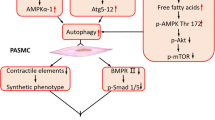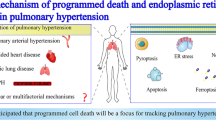Abstract
Pulmonary hypertension (PH) is a very common kind of pulmonary vascular disease, which can cause a heavier burden on patient’s quality of life, even lead to death. Yet, the mechanism of PH is incomprehensive and not so clear nowadays. In recent years, more and more studies show that autophagy plays a pivotal role in the development of PH. Some modalities target on the formation or maturation of autophagosome that has emerged from our increasing knowledge of autophagy machinery, which may prevent or eliminate the process of PH. The deciphering of molecular selectivity of autophagy has also been a source of novel modulators that act specifically on selective forms of autophagy. Tremendous recent progress has opened a new possibility for modulating autophagy in complex diseases. Thus, autophagy may become a prospective choice for treatment of PH. Herein, we reviewed the literatures and discussed the role of autophagy in the development and treatment of PH.


Similar content being viewed by others
Abbreviations
- AMPK:
-
Adenosine monophosphate–activated protein kinase
- BMPR-II:
-
Bone morphogenetic protein receptor type II
- CaMKK-β:
-
Calmodulin-dependent protein kinase kinase-β
- CFZ:
-
Carfilzomib
- CMA:
-
Chaperone-mediated autophagy
- CTEPH:
-
Chronic thromboembolic PH
- DAPK:
-
Death-associated protein kinase
- E2:
-
17β-estradiol
- ER:
-
Endoplasmic reticulum
- ERK:
-
Extracellular signal-regulated kinases
- FAS:
-
Fatty acid synthase
- LC3:
-
Light chain 3
- LV:
-
Left ventricular
- MAPK:
-
Mitogen-activated protein kinases
- mTOR:
-
Mammalian target of rapamycin
- PAH:
-
Pulmonary arterial hypertension
- PASMCs:
-
Pulmonary artery smooth muscle cells
- PH:
-
Pulmonary hypertension
- PHC:
-
Pulmonary hypertension connections
- PI3K:
-
Phosphatidylinositol 3-kinase
- REVEAL:
-
Registry to evaluate early and long-term pulmonary arterial hypertension disease management
- RV:
-
Right ventricular
- Ucp2:
-
Uncoupling protein 2
- ULK1:
-
Unc-51 like kinase 1, UPS:Ubiquitin–proteasome system
References
Galiè N, Humbert M, Vachiery JL et al (2015) 2015 ESC/ERS guidelines for the diagnosis and treatment of pulmonary hypertension: the joint task force for the diagnosis and treatment of pulmonary hypertension of the european society of cardiology (ESC) and the European Respiratory Society (ERS): Endorsed by: Association for European Paediatric and Congenital Cardiology (AEPC), International Society for Heart and Lung Transplantation (ISHLT). Eur Respir J 46:903–975
François CJ, Schiebler ML (2016) Imaging of pulmonary hypertension. Radiol Clin North Am 54:1133–1149
Hoeper MM, Humbert M, Souza R et al (2016) A global view of pulmonary hypertension. Lancet Respir Med 4:306–322
Thenappan T, Ryan JJ, Archer SL (2012) Evolving epidemiology of pulmonary arterial hypertension. Am J Respir Crit Care Med 186:707–709
George MG, Schieb LJ, Ayala C et al (2014) Pulmonary hypertension surveillance: United States, 2001 to 2010. Chest 146:476–495
Klionsky DJ (2008) Autophagy revisited: a conversation with Christian de Duve. Autophagy 4:740–743
Ohsumi Y (2014) Historical landmarks of autophagy research. Cell Res 24:9–23
Wu DJ, Adamopoulos IE (2017) Autophagy and autoimmunity. Clin Immunol 176:55–62
Tai S, Hu XQ, Peng DQ et al (2016) The roles of autophagy in vascular smooth muscle cells. Int J Cardiol 211:1–6
Ciechanover A, Orian A, Schwartz AL (2000) Ubiquitin-mediated proteolysis: biological regulation via destruction. Bioessays 22:442–451
Kenney DL, Benarroch EE (2015) The autophagy-lysosomal pathway: General concepts and clinical implications. Neurology 85:634–645
Morel E, Mehrpour M, Botti J et al (2017) A Druggable Process. Annu Rev Pharmacol Toxicol 57:375–398
Martinet W, Agostinis P, Vanhoecke B et al (2009) Autophagy in disease: a double-edged sword with therapeutic potential. Clin Sci (Lond) 116:697–712
Haspel JA, Choi AM (2011) Autophagy: a core cellular process with emerging links to pulmonary disease. Am J Respir Crit Care Med 184:1237–1246
Farré JC, Subramani S (2016) Mechanistic insights into selective autophagy pathways: lessons from yeast. Nat Rev Mol Cell Biol 17:537–552
Noda NN, Inagaki F (2015) Mechanisms of autophagy. Annu Rev Biophys 44:101–122
Klionsky DJ, Cregg JM, Dunn WA Jr et al (2003) A unified nomenclature for yeast autophagy-related genes. Dev Cell 5:539–545
Hosokawa N, Sasaki T, Iemura S et al (2009) Atg101, a novel mammalian autophagy protein interacting with Atg13. Autophagy 5:973–979
Kundu M, Thompson CB (2008) Autophagy: basic principles and relevance to disease. Annu Rev Pathol 3:427–455
Dupont N, Nascimbeni AC, Morel E et al (2017) Molecular mechanisms of noncanonical autophagy. Int Rev Cell Mol Biol 328:1–23
Kabeya Y, Mizushima N, Ueno T et al (2000) LC3, a mammalian homologue of yeast Apg8p, is localized in autophagosome membranes after processing. EMBO J 19:5720–5728
Ryter SW, Choi AM (2015) Autophagy in lung disease pathogenesis and therapeutics. Redox Biol 4:215–225
Nguyen N, Shteyn V, Melia TJ (2017) Sensing membrane curvature in macroautophagy. J Mol Biol 429:457–472
Wullschleger S, Loewith R, Hall MN (2006) TOR signaling in growth and metabolism. Cell 124:471–484
Pattingre S, Espert L, Biard-Piechaczyk M et al (2008) Regulation of macroautophagy by mTOR and Beclin 1 complexes. Biochimie 90:313–323
Aggarwal S, Mannam P, Zhang J (2016) Differential regulation of autophagy and mitophagy in pulmonary diseases. Am J Physiol Lung Cell Mol Physiol 311:L433–L452
Lee J, Giordano S, Zhang J (2012) Autophagy, mitochondria and oxidative stress: cross-talk and redox signalling. Biochem J 441:523–540
Dromparis P, Michelakis ED (2013) Mitochondria in vascular health and disease. Annu Rev Physiol 75:95–126
Marsboom G, Toth PT, Ryan JJ et al (2012) Dynamin-related protein 1-mediated mitochondrial mitotic fission permits hyperproliferation of vascular smooth muscle cells and offers a novel therapeutic target in pulmonary hypertension. Circ Res 110:1484–1497
Deng C, Wu D, Yang M et al (2016) The role of tissue factor and autophagy in pulmonary vascular remodeling in a rat model for chronic thromboembolic pulmonary hypertension. Respir Res 17:65
Teng RJ, Du J, Welak S et al (2012) Cross talk between NADPH oxidase and autophagy in pulmonary artery endothelial cells with intrauterine persistent pulmonary hypertension. Am J Physiol Lung Cell Mol Physiol 302:L651–L663
Antonioli M, Di Rienzo M, Piacentini M et al (2017) Emerging mechanisms in initiating and terminating autophagy. Trends Biochem Sci 42:28–41
Mizumura K, Cloonan S, Choi ME et al (2016) Autophagy: friend or foe in lung disease? Ann Am Thorac Soc 13:S40–S47
Morales-Cano D, Menendez C, Moreno E et al (2014) The flavonoid quercetin reverses pulmonary hypertension in rats. PLoS One 9:e114492
He Y, Cao X, Guo P et al (2016) Quercetin induces autophagy via FOXO1-dependent pathways and autophagy suppression enhances quercetin-induced apoptosis in PASMCs in hypoxia. Free Radic Biol Med 103:165–176
Liu Y, Shoji-Kawata S, Sumpter RM Jr et al (2013) Autosis is a Na+,K+-ATPase-regulated form of cell death triggered by autophagy-inducing peptides, starvation, and hypoxia-ischemia. Proc Natl Acad Sci U S A 110:20364–20371
Liu Y, Levine B (2015) Autosis and autophagic cell death: the dark side of autophagy. Cell Death Differ 22:367–376
Long L, Yang X, Southwood M et al (2013) Chloroquine prevents progression of experimental pulmonary hypertension via inhibition of autophagy and lysosomal bone morphogenetic protein type II receptor degradation. Circ Res 112:1159–1170
Randhawa PK, Jaggi AS (2016) TRPV1 channels in cardiovascular system: a double edged sword? Int J Cardiol 228:103–113
Meiners S, Ballweg K (2014) Proteostasis in pediatric pulmonary pathology. Mol Cell Pediatr 1:11
Li L, Wang X, Wang L et al (2015) Mammalian target of rapamycin overexpression antagonizes chronic hypoxia-triggered pulmonary arterial hypertension via the autophagic pathway. Int J Mol Med 36:316–322
Zhang H, Gong Y, Wang Z et al (2014) Apelin inhibits the proliferation and migration of rat PASMCs via the activation of PI3K/Akt/mTOR signal and the inhibition of autophagy under hypoxia. J Cell Mol Med 18:542–553
Cheng Y, Ren X, Hait WN et al (2013) Therapeutic targeting of autophagy in disease: biology and pharmacology. Pharmacol Rev 65:1162–1197
Choi AM, Ryter SW, Levine B (2013) Autophagy in human health and disease. N Engl J Med 368:651–662
Nakahira K, Choi AM (2013) Autophagy: a potential therapeutic target in lung diseases. Am J Physiol Lung Cell Mol Physiol 305:L93–L107
Lippai M, Szatmári Z (2017) Autophagy-from molecular mechanisms to clinical relevance. Cell Biol Toxicol 33:145–168
Mizumura K, Choi AM, Ryter SW (2014) Emerging role of selective autophagy in human diseases. Front Pharmacol 5:244
Fraidenburg DR, Yuan JX (2013) Hungry for more: autophagy in the pathogenesis of pulmonary arterial hypertension. Circ Res 112:1091–1093
Wang W, Liu J, Ma A et al (2014) mTORC1 is involved in hypoxia-induced pulmonary hypertension through the activation of Notch3. J Cell Physiol 229:2117–2125
Singh N, Manhas A, Kaur G et al (2016) Inhibition of fatty acid synthase is protective in pulmonary hypertension. Br J Pharmacol 173:2030–2045
Lahm T, Frump AL, Albrecht ME et al (2016) 17β-Estradiol mediates superior adaptation of right ventricular function to acute strenuous exercise in female rats with severe pulmonary hypertension. Am J Physiol Lung Cell Mol Physiol 311:L375–L388
Haslip M, Dostanic I, Huang Y et al (2015) Endothelial uncoupling protein 2 regulates mitophagy and pulmonary hypertension during intermittent hypoxia. Arterioscler Thromb Vasc Biol 35:1166–1178
Wang X, Ibrahim YF, Das D et al (2016) Carfilzomib reverses pulmonary arterial hypertension. Cardiovasc Res 110:188–199
Dalvi P, Sharma H, Chinnappan M et al (2016) Enhanced autophagy in pulmonary endothelial cells on exposure to HIV-Tat and morphine: role in HIV-related pulmonary arterial hypertension. Autophagy 12:2420–2438
Zhang L, Cui L, Zhou G et al (2013) Pterostilbene, a natural small-molecular compound, promotes cytoprotective macroautophagy in vascular endothelial cells. J Nutr Biochem 24:903–911
Mao M, Yu X, Ge X et al (2017) Acetylated cyclophilin A is a major mediator in hypoxia-induced autophagy and pulmonary vascular angiogenesis. J Hypertens 35:798–809
Funding
None declared.
Author information
Authors and Affiliations
Corresponding author
Ethics declarations
Conflict of interest
The author declares that he has no conflict of interests.
Statement of human and animal rights
This article does not contain any studies with human participants performed by any of the authors.
Informed consent
For this type of study, formal consent is not required.
Rights and permissions
About this article
Cite this article
Chen, Yb. Autophagy and its role in pulmonary hypertension. Aging Clin Exp Res 31, 1027–1033 (2019). https://doi.org/10.1007/s40520-018-1063-1
Received:
Accepted:
Published:
Issue Date:
DOI: https://doi.org/10.1007/s40520-018-1063-1




